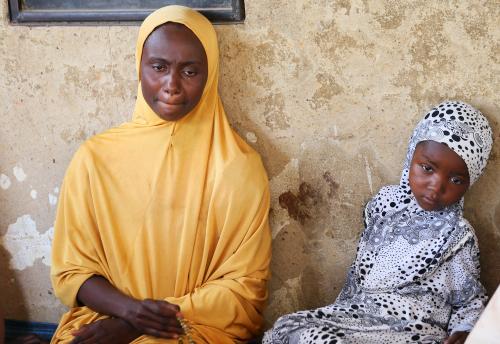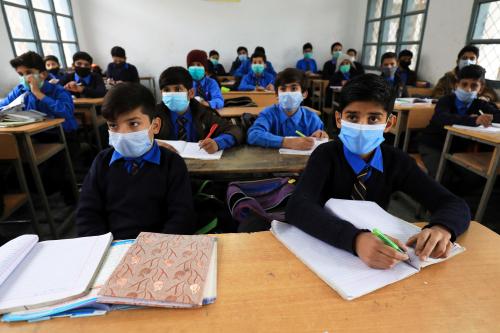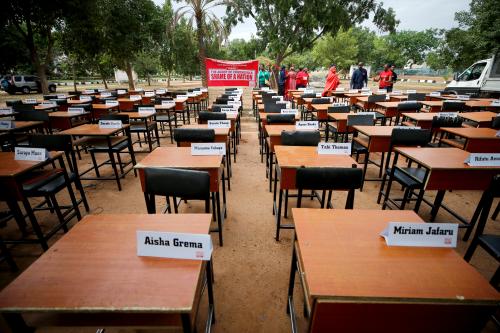June 20 was International Refugee Day, a fitting moment for the world to focus on the plight of the 60 million and rising number of displaced people. As the British-Somali poet Warsan Shire put it, “No one leaves home, unless home is the mouth of a shark.” But there are also millions who are unable to escape, lacking the means or fearful of bigger “sharks” further afield. Meanwhile, their home is being brutalized by violence and reconfigured to fit some ideological straightjacket. They may not be geographically displaced, but these people are victims too. Especially when they are children, whose schools and socializing processes are radically transformed to conform to the new regime.
Underlining the dangers facing children, on May 8 the U.N. circulated an advance copy of the 2015 U.N. General Assembly Report on Children and Armed Conflict to members of the Security Council. The report received wide coverage, partly for its “Children’s List of Shame,” the list of armies and groups that kill or maim children. Issued annually since 2005, the report states that 2014 saw unprecedented levels of violence against children. Some 57 armies and armed groups from 11 countries are on the list of shame. The list includes persistent perpetrators, i.e. those so identified for at least 5 years. Iraq, Syria, and Yemen are on the list of shame. This year’s report highlights the increasing trend of mass abductions, a hallmark of the Islamic State group among others. Also stressed is the deliberate targeting of schools by various groups, because of their secular curriculums, girls education, and other ideologically objectionable reasons, but also because they are soft targets with high emotional impact. Radical groups will often change curricula to fit their worldview or simply shut the schools down. Many groups use violence as a means to indoctrinate children, a practice not unique to the Islamic State. Children are “recruited” by all sides in Iraq, Syria, and Yemen. The U.N. report and others therefore strongly underline the need for comprehensive programs to reintegrate children who have been subject or witness to endemic violence.
The Islamic State group, however, stands out. Iraqi psychologists say they have never seen more terrible trauma than that caused by the Islamic State. They also stand out because of their determination to take and hold territory and start socializing these populations in their worldview.
The Islamic State group has many camps in Syria, and now in Iraq, where it trains children militarily and ideologically. The so-called “cubs” are targeted via enlistment centers focusing on 14-15 year-olds, but also those as young as 10. Some are abducted, others volunteer, a few are brought in by their parents. Classes of 40-60 go through a month of training with religious courses, physical education, and military skills. They are not immediately sent to fight but are kept close to the fighters and to the front lines.
The impact on children also extends beyond the camps. It is estimated that some 6-8 million people live in Islamic State group-controlled areas and that roughly a third of these are children. This means that some 2 million children under 18 years of age are now potentially cut off from a regular education and modes of socialization—a ready pool of recruits that is likely to grow in importance as Islamic State group solidifies its hold. Note that Raqqa, Islamic State group’s self-declared capital, fell over two years ago in March 2013 and Mosul with over a million people has been under Islamic State group control for over a year. And these are just the two largest Islamic State group held urban areas.
Children living in Islamic State group-controlled territory grow up in an environment where violence—from brutal executions to lashings to vicious beatings—is endemic and public. Strict segregation is imposed on both sexes while a discourse of harsh exclusion applies to other religions and sects. As in Raqqa, the Mosul school year began with all teachers told to report to their schools to be indoctrinated in the Islamic State group worldview with an Egyptian “emir” overseeing education. Banned subjects included history, geography, literature, art, music, psychology, and others. All reference to Iraq and Syria are removed. Religious courses focusing on Jihad fill the void. In the meantime, the Ministry of Education in Baghdad continues to pay the salaries of teachers while Islamic State group has instituted monthly school fees ranging from 25,000 Iraqi Dinars ($21) for kindergarten to 50,000 ($42) Dinars for high school and 75,000 ($63) Dinars for undergraduates in colleges. Presumably this will eventually go toward paying for education and other services, as in Syria where the Islamic State group now forbids any payments from the Damascus government.
For now, implementation remains uneven and Islamic State group lacks the numbers for total control. But that may change over time, as it becomes clearer that these cities and other areas under Islamic State group occupation do have an administration able to impose order—albeit brutally at times—and with technocrats available to oversee service delivery.
What is clear is that Islamic State group’ territorial imperative and focus on socializing a whole new generation while trying to build support through service delivery means that simple military means will not suffice. Programs of de-indoctrination may be needed to reintegrate the population, especially the young, as the Islamic State group is dislodged. A Kurdish official underlined the crux of the challenge: “The biggest threat we have is that the children have a new curriculum that is very extremist…This is a ticking time bomb for the future.”
The Brookings Institution is committed to quality, independence, and impact.
We are supported by a diverse array of funders. In line with our values and policies, each Brookings publication represents the sole views of its author(s).




Commentary
The Islamic State group, refugees, and the children left behind
June 22, 2015